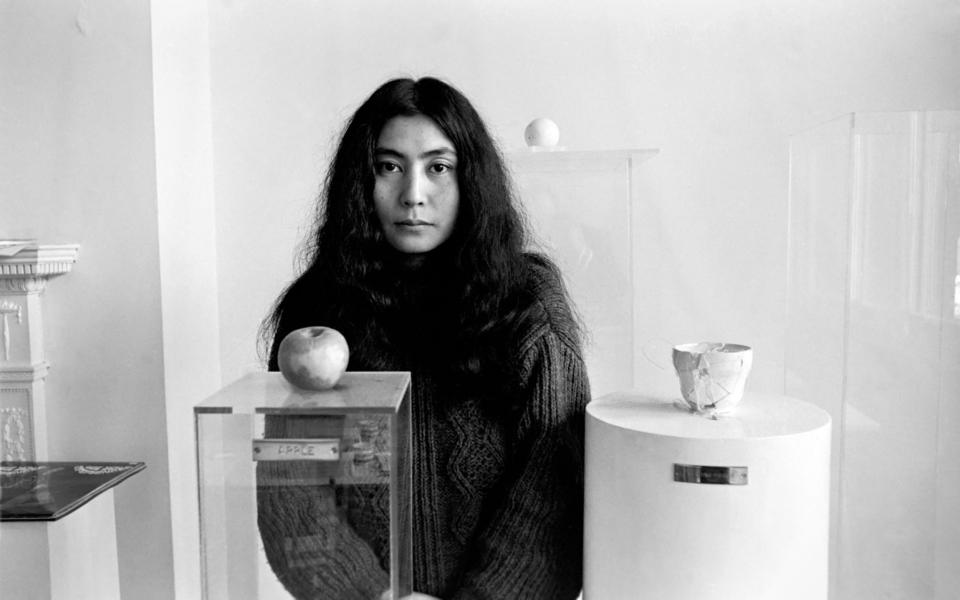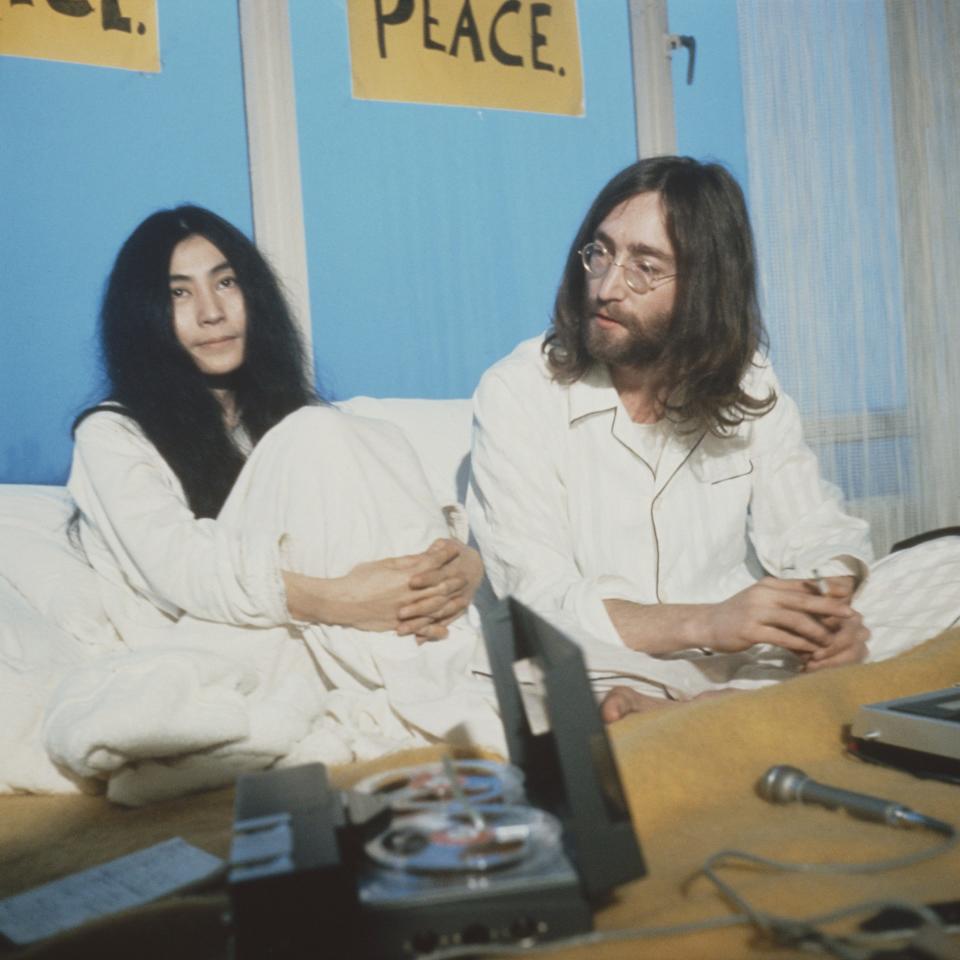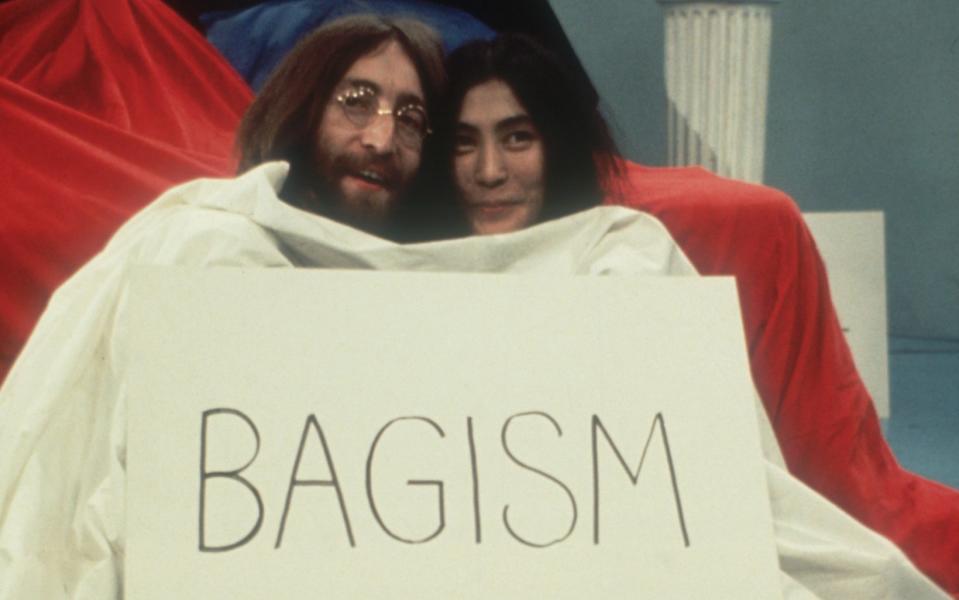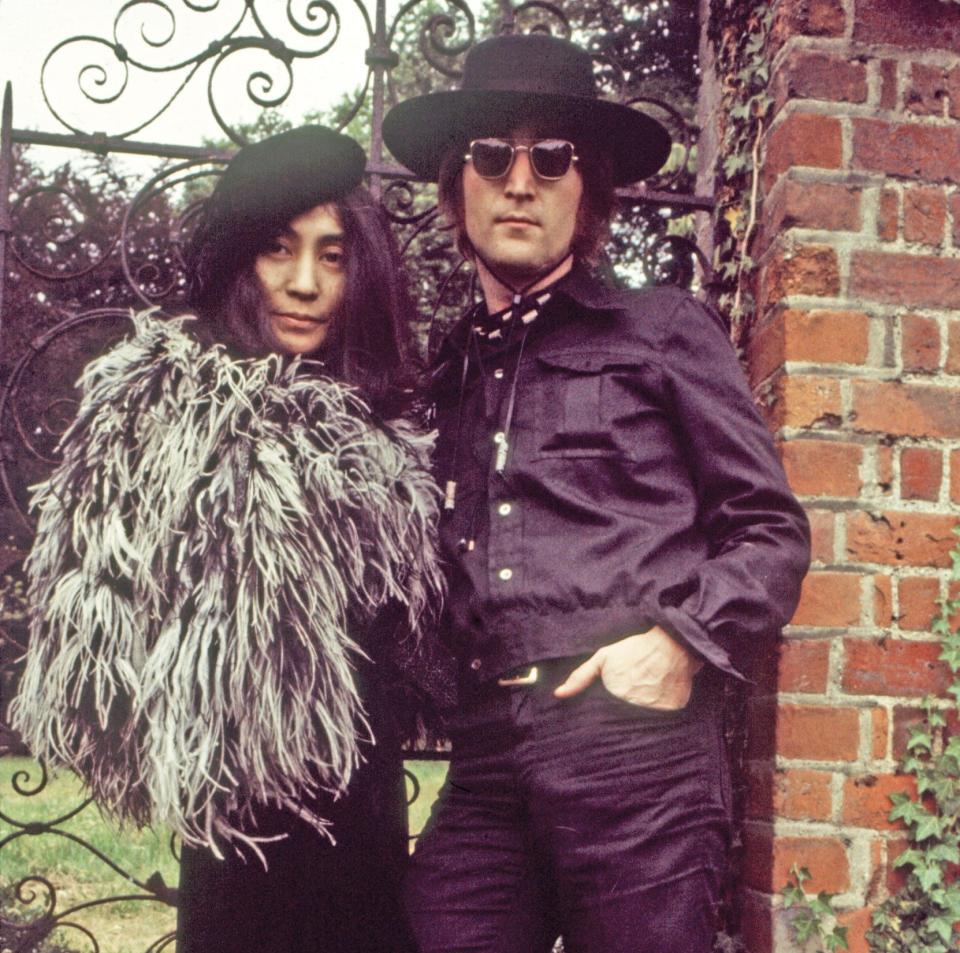From hate-figure to major artist: how the world learnt to love Yoko Ono

In a new exhibition of her work at Tate -Modern, Yoko Ono is described as “a leading figure in conceptual and performance art, experimental film and music”. This is true, but omits what most people would think of when the 90-year-old -artist’s name comes to mind – her years, throughout the 1970s, as the wife and collaborator of John Lennon.
It was a decade in which Ono was the object of hostility, seen by many bewildered Beatles fans as the interloper who had “stolen” Lennon from the group, and turned their chippy, witty hero into a strangely alien character, sitting for days in an Amsterdam hotel bed for “peace” and posing stark naked on an album sleeve.
But that was then.
In the years since Lennon’s death in 1980, Ono has been the standard bearer of his legacy. As well as funding the Strawberry Fields memorial in -Manhattan’s Central Park, across the road from the Dakota building where they lived (and in the entrance of which Lennon was shot dead), she has made phil-anthropic contributions to the arts, disaster relief and other causes. During the Covid pandemic, she finally moved out of the Dakota and into a 600-acre farm in upstate New York – part of an extensive property portfolio built up by Ono, whose net worth has reached $700 million (£557 million).
Her recordings (once played to detainees at Guantanamo Bay as form of “noise stress” torture) have enjoyed belated acclaim, embraced by a younger audience who have no sentimental associations with the Beatles. It is a vindication, in a way, of Lennon’s belief that Ono was an important avant-garde artist waiting for the world to catch up.
Her artworks, too, continue to be exhibited internationally. Last August, a New York gallery was obliged to shut down an installation of her work Ex It – an indoor -arboretum of trees planted in -coffins – after four of the trees died. (Or perhaps that was the point…)
The Tate exhibition, Music of the Mind, presents a long-overdue opportunity, says the curator Juliet Bingham, to reappraise her significance. Ono, Bingham says, has been “the subject of criticism from various quarters over the years, much of it very unfair… What the new exhibition shows is that she was very well established in both musical and avant-garde circles before she came to London.”
Born in Tokyo, into one of Japan’s wealthiest families, Ono arrived in New York in 1952, -establishing herself as a central figure in the conceptual-arts -movement Fluxus.

She married, then divorced, Toshi Ichiyanagi, an avant-garde pianist and composer, before -marrying Tony Cox, who had been hustling on the New York art scene before setting his sights on Ono, and with whom she had a daughter, Kyoko.
Cox became her promoter, -producing her Film No 4 (Bottoms) – a movie, later banned, consisting of fleeting glimpses of 365 bare bottoms, based on Ono’s minimalist script: “String bottoms together in place of signatures for petition for peace.”
In the same year, the couple moved to London, where, on November 7, John Lennon walked into Ono’s exhibition at the Indica Gallery. Ono greeted him with a card reading “Breathe”, before leading him to a ladder propped against the wall. Climbing to the top, he squinted through a magnifying glass to read another card, printed with the -single word “Yes”.
Also on show was Painting to Ham-mer a Nail – a hammer att-ach-ed to a block into which people were invited to hammer nails.
“I said, ‘Can I hammer a nail in?’” Lennon later recalled, “and she said no, because the gallery was actually opening the next day. So the owner, [John] Dunbar, says, ‘Let him hammer a nail in.’ It was, ‘He’s a millionaire. He might buy it,’ you know. [...] So there was this little conference and she finally said, ‘OK, you can hammer a nail in for five shillings.’ So smart-ass here says, ‘Well, I’ll give you an imaginary five shillings and hammer an imaginary nail in.’ And that’s when we really met.”
As Lennon was leaving, Ono -followed, saying, “Take me with you.” He brushed her off. But Ono persisted. And Lennon was sold.

Ono would later claim that she did not know who the Beatles were at the time. But in his memoir, In The Sixties, Barry Miles, who co-owned the Indica gallery, wrote that a week before her opening Yoko had visited Paul McCartney trying to get him to donate the manuscript of one of his songs to a collection of modern scores she was assembling. Paul turned her down and suggested she ask John.
“Like many artists,” Miles wrote, Yoko “was concerned solely with herself and her art.”
As Lennon later remarked, possibly joking, “To Yoko men are just assistants.”
Within a few months, she had separated from Cox, who, after a bitter court battle over the -custody of Kyoko, took their daughter with him into hiding, and joined the Church of the Living Word, a -millenarian cult where adherents were exhorted to believe that the leader, John Robert Stevens, was Jesus Christ. Not until 1994, when she was 31 years old, did Kyoko re-establish contact with her mother.
So began the be-ins, bed-ins and bag-ins. (“The newspapers said, ‘She’s gone to his head,’” Lennon sang in 1969’s The Ballad of John and Yoko, “They look just like two gurus in drag.”)

She was put in the stocks of -public opinion and pelted with insults, brickbats and jokes, many explicitly racist – finally driving John and Yoko out of Britain to make a new life in New York.
And it wasn’t just the public. According to an interview that Lennon gave Rolling Stone magazine in 1971, “[The other Beatles] all sat there with their wives, like a f---ing jury, and judged us. Ringo was alright, so was Maureen, but the other two really gave it to us [...] I can’t forgive ’em for that really; although I can’t help still loving them either.”
The accusation that Yoko was the woman who had broken up the Beatles was true, to a point. As Lennon told Rolling Stone, “it seemed that I had to be married to them or Yoko, and I chose Yoko, and I was right.” (Momentarily forgetting, perhaps, that at the time of their meeting he was actually married to Cynthia, the girl he’d met at Liverpool Art College, from whom he constantly borrowed the pens and pencils he’d forgotten to bring with him, and with whom he had a son Julian).
The popular idea was that Ono had bewitched and corrupted Lennon. In his view, she had saved him. Lennon was sick; sick of the Beatles, sick of fame and of being public property, sick of being John Lennon.
Together they went through -heroin addiction, primal screaming to exorcise their pain, separation and reconciliation. Then, as Lennon and Ono were returning home to the Dakota building on December 8 1980, a deranged fan, Mark Chapman, stepped forward, pistol in hand.
Five months after Lennon’s death, Ono invited the journalist Philip Norman to meet her at her home. It was not true, she told him, that she had a hold over Lennon. After they started living together, it was John who wanted her there all the time.
There was a story that she was so proprietorial of Lennon that during recording sessions at Abbey Road she would follow him into the lavatory. The truth, she said, was, “he made me go into the men’s room with him. He was afraid that if I stayed out in the studio with a lot of other men, I might run off with one of them. He wrote a song called Jealous Guy; that should have told you the way he was.”
He didn’t even like her reading or speaking Japanese, because it was a part of her that wasn’t him.

After Lennon’s death, she said, Ringo was the only Beatle to fly to New York to comfort her. The Beatles had once contemptuously called her “Flavour of the Month”. She drily referred to them as “the in-laws”. Now, it was as if Lennon’s death had finally wiped clean all the old resentment and suspicion. It was a feeling almost as strange as bereavement, Norman wrote, for Ono to realise that people did not hate her any more – a hatred that “had seemed as durable as the Beatles legend”.
Norman struck up a relationship with Ono and she gave him a series of interviews for his Bible-length biog-raphy John Lennon: The Life (2008). Ono had given her co-operation on the condition that she read the man-u-script for accuracy. He agreed, but was surprised to be told later that she was upset by the book and would not endorse it, because Norman had been “mean to John”.
“I’d written about John in the way Yoko had always talked about him, with a sort of exasperated fondness,” Norman later told me, clearly taken aback.
“She’d read the unedited manuscript, and initially the -message came back from her that someone else had read it and it was really great.
“And then she said, could I pop over to have a cup of tea before I caught my plane back to London, and she would show me a page from John’s diary that I could use in the book.
“As I walked across Central Park, it popped into my mind, maybe she’s waiting with a lawyer; in fact, she was waiting with two lawyers, and another woman who I didn’t know… Yoko started to upbraid me for things I’d said about John in the book, and she said, ‘How could you say John masturbated?’ And this woman suddenly went, ‘Eugh!’ And I realised Yoko had a personal shudderer, someone who shuddered for her. But Yoko herself had told me the story of how John and Paul would sit around in the twilight calling out the names of sex idols of the time like Brigitte Bardot, and John would spoil it by shouting out names like Winston Churchill.”
Norman continued: “Despite the huge cultural differences between them, she and John were strangely alike. Like John, she could be an apparently warm, amiable person and could change in a split second to being hard and cold and ruthless.”
In 2003, I travelled to Paris to meet Ono, where she was performing her work Cut Piece. First staged in Kyoto in 1964, it involves the artist sitting on stage and inviting members of the audience to cut off pieces of her clothing with a pair of tailor’s scissors. Apart from the novelty of seeing Ono being snipped at rather than sniped at, the connection to world peace seemed remote.
But as she sat there for 75 minutes, staring passively forward without a movement or sound, as people processed past her – some timidly, some with an almost religious gravitas, some determined to make an artistic contribution of their own – and bits of clothing fell to the floor, the connection became more apparent, the implicit meanings bubbling to the surface: trust, self-sacrifice and courage.
How many other 70-year-old women would expose their bodies to such ruthless public scrutiny? How many would expose themselves to the risk of strangers with a potentially fatal weapon – even leaving aside the spectre of the assassination of her husband?
“We live in a very dangerous age now,” Ono told me the following morning, ensconced in the com-parative safety of a suite at the Ritz. “It’s almost as if the people ‘up there’, the politicians, or the faceless people who are controlling the politicians – let’s say war people, as opposed to peace people – want us to be intimidated so we can’t fight for peace.”
The invasion of Iraq had taken place a few months earlier. This, she said, was “the time we should really be opening up to each other, trusting each other and coming together in love to do something about the situation. And I think John would have thought the same thing.”
Their relationship, she said, had served as a catalyst to “create a lot of interesting work”. “As John put it, our attraction was a spiritual one,” she smiled. “But, just by the way, physically it was OK, too. But it was true, we were very ‘head’ people. Our work was very important for both of us. It was an artistic relationship” – a relationship, she suggested, of which his utopian anthem Imagine was the defining statement.

In the 1970s, Lennon had claimed the inspiration for the song was a “prayer-book” by the comedian and activist Dick Gregory. But a more explicit influence was Ono’s book Grapefruit, a collection of her “instructional poems” (“imagine a goldfish”, “imagine a raindrop”). One of the instructions from Grapefruit was printed on the Imagine album sleeve: “Imagine the clouds dripping, dig a hole in your garden to put them in.”
It was only later, in a radio interview conducted shortly before his death, that Lennon acknowledged that such had been Ono’s contribution to the song that she should rightfully have been credited as co-composer, but that he was “too macho” to think of sharing the credit with her at the time.
Ono, who was with Lennon when he gave that interview, and told me that she greeted his pronouncement with some alarm.
“I was thinking, ‘Oh, oh, you shouldn’t be saying that,’” she told me. “That’s how I felt. Because I have been a figure that was not -necessarily loved, and I was worried that the fact that I had anything to do with the song would have been considered as an interference to its popularity.”
In recent years, Ono has become a reclusive figure, dogged by ill-health, and requiring round-the-clock care. But in 2017, she made a rare public appearance to collect a Centennial Song Award for Imagine, on behalf of her husband. As she sat in her wheelchair on stage, her son Sean beside her, the hosts surprised her by playing a clip of that very radio interview, where Lennon said she should rightfully have been credited as co-composer of the song. “This,” she told the audience, her face lighting up with a smile, “is the best time of my life.”
Yoko Ono: Music of the Mind is at Tate Modern, London SE1 (tate.org.uk) from Thurs to Sept 1